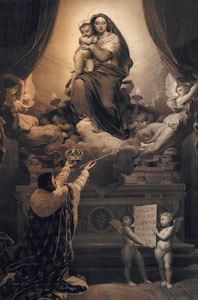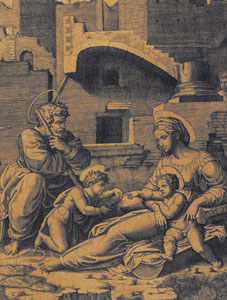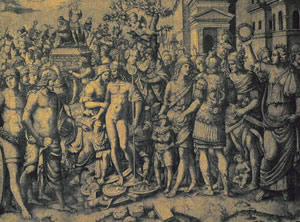Shallow graves
 Engraving has been a common practice, since the 15th century, of multiplying copies of famous paintings. The engraver uses a chisel to cut the lines of a drawing into a metal sheet. Once the drawing is finished, the engraved sheet is covered with ink, which fill the thin channels, while the flat surfaces remain clear. A sheet of paper is pressed against the metal sheet, to create a print. An indefinite number of copies can be produced in this manner and you, the engraver, are hailed in Nuremberg and in Venice alike, like Durer, Albrecht to his friends, or you can call him Al.
Engraving has been a common practice, since the 15th century, of multiplying copies of famous paintings. The engraver uses a chisel to cut the lines of a drawing into a metal sheet. Once the drawing is finished, the engraved sheet is covered with ink, which fill the thin channels, while the flat surfaces remain clear. A sheet of paper is pressed against the metal sheet, to create a print. An indefinite number of copies can be produced in this manner and you, the engraver, are hailed in Nuremberg and in Venice alike, like Durer, Albrecht to his friends, or you can call him Al.
Forty of these prints by European masters from the 16th to the 19th centuries are now on display at the National Art Museum of Romania. The exhibition follows the evolution of engraving from an artform that reproduced paintings to a craft in its own value, with original subject matter and its own virtuosos of the line.
 It is true, never-theless, that the majority of the prints belong to engravers who aimed at no more than mass-marketing the works of fashionable painters of the time. One of the best engravers, the Italian Marcantonio Raimondi, gained a certain amount of fame only by reproducing Raphael’s works in a decent enough way. With very few exceptions, such as that of Albrecht Durer and Hendrick Golzius, the obscure names of the engravers did not receive more praise than a prompt at the theatre.
It is true, never-theless, that the majority of the prints belong to engravers who aimed at no more than mass-marketing the works of fashionable painters of the time. One of the best engravers, the Italian Marcantonio Raimondi, gained a certain amount of fame only by reproducing Raphael’s works in a decent enough way. With very few exceptions, such as that of Albrecht Durer and Hendrick Golzius, the obscure names of the engravers did not receive more praise than a prompt at the theatre.
The cast members of the 16th to the 18th centuries engravings are made up mainly of mythological and biblical characters. The muscular thighs of the gods, the opulent bosoms of the queens draped in rich veils, their curls and the stormy clouds above foreboding tragic destinies give the engraver the opportunity to show off his craftsmanship.
This is also the case of the work by Albrecht Durer present in the exhibition, but his ‘Rape of Amymona’ is not exactly the peak of the illustrious German’s career. The pose of the characters is fake and stiff and the whole picture is annoyingly mannerist.
Durer’s ‘14 stations of the Passions of Christ’, for example, is in another league, but, if you want to see those, you’re in the wrong capital.
So Durer is not the star of the exhibition.
 Maybe the most interesting items are two prints of ‘Louis XIII paying his vows’, after the same engraving, but in two different stages of completion: one is finished, the other not. As the two works are placed facing each other from opposing walls, they form an imperfec mirror. But strangely enough, it is comforting to see, among the other prints of the exhibition, something incomplete.
Maybe the most interesting items are two prints of ‘Louis XIII paying his vows’, after the same engraving, but in two different stages of completion: one is finished, the other not. As the two works are placed facing each other from opposing walls, they form an imperfec mirror. But strangely enough, it is comforting to see, among the other prints of the exhibition, something incomplete.
Anca Pol
‘Masters of engraving with a chisel’ [Maestrii gravurii cu daltita], National Museum of Art, 49-53 Calea Victoriei, Wednesdays to Sundays, 11:00 hrs to 19:00 hrs, until 29 October
